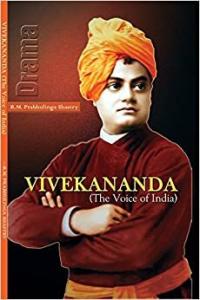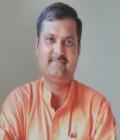Creation and Criticism
ISSN: 2455-9687
(A Quarterly International Peer-reviewed Refereed e-Journal
Devoted to English Language and Literature)
Vol. 07, Joint Issue 24 & 25: Jan-April 2022

Research Paper
Cultural Communication in Vivekananda (The Voice of India)
Abnish Singh Chauhan
Abstract
R.M. Prabhulinga Shastry’s Vivekananda (The Voice of India) is a three-act play based on awakening dialogues on the being, the super-being, the Almighty, the soul, the world, Maya, duty, education, knowledge, marriage, truth, consciousness, love, sage or rishi, life, death, birth, rebirth, ultimate purpose of life, etc. for blissful living. In fact, these vivid and colorful dialogues on various subjects of socio-cultural and spiritual values are courteously taken from the real speeches of Swami Vivekananda, who himself is the most significant character of this play, and are intimately and intensely revealed during his communication with the other fictitious characters hailing from different parts of the world. The play, particularly through asking and answering questions, distinctively reproduces the practical philosophy of life as revealed in the Vedic literature for the thoughtful development of the global audience.
Keywords: Cultural Communication, Dialogues, Vedic Philosophy, Western Philosophy, God, Soul, Truth, Duty, Ultimate Purpose, Human Development, Blissful Living
(1)
R.M. Prabhulinga Shastry’s Vivekananda (The Voice of India), a play of spiritual ideas, explores the universal messages of Swami Vivekananda through the imaginary portrayal of Swami Vivekananda along with some other characters from the East and the West in its three-act narrative structure. The play disseminates the essence of Vedic philosophy and its wonderful influence on man and manners of the contemporary world through the amalgamation of some real dialogues, taken from the speeches of Swami Vivekananda, along with the fictitious conversations in the forms of questions and answers, created for the ultimate purpose of human development.
Vivekananda (The Voice of India) begins with an anthem (behind curtain), glorifying Swamiji as “eternal voice from the East” (1). The noun “voice”, which denotes the divine truth (Bible), is modified by an adjective “eternal” meaning lasting or existing forever and “the East” symbolically stands for the rising of the sun— the great source of light and delight as well as the birth place of great sages or rishis like Swami Vivekananda, who is known as a ‘handsome oriental’, ‘impressive orator’, ‘representative of the Hindu monastic order’, ‘spokesman of Indian spiritualism’ etc., since the beginning of the human civilization.
(2)
Act I, Scene I of Prabhulinga Shastry’s Vivekananda starts with a brief descriptive note about the presence of its ice-breaking character Haranath sitting at the bank of a ‘river’— the living body of Nature, and thereafter the entry of Fernondez. Haranath is doing ‘japa’ of Om Namah Shivaya mantra, a most powerful and popular mantra for self-realization, before Shivalinga. He is doing this with full awareness. Fernondez comes over there and interrupts him through his curious remarks. And thus the preliminary note leads to the dialogues between them. Fernondez calmly asks Haranath, “What are you doing?” (21) and then “How can you suppose this (sculptured stone) is the Almighty?” (22) Haranath converses with him, but could not give a proper reply. Meanwhile, Swami Vivekananda enters the scene and speaks thus, “He always worshipped the Omnipresent being in the stone” (23). They greet him. Swamiji blesses them. Fernondez asks Swamiji some questions about Being, Super-being, Lord Param Shiva, the Omnipresent, the Almighty, stone-worshipping, etc. and subsequently gets the satisfactory answers in modern and universalistic explanations quoted from his texts in bold letters. The scene ends with the remarkable message of Swami Vivekananda— “The highest worship is that of the man who loves God for God’s sake as emphasized in the Vedic literature” (28).
Act I, Scene II begins with Swami Vivekananda sitting on a small cot and meditating. Meanwhile, Donne and Marlow come there and, on being asked, sit in the chairs before him. They also want to know ‘the Almighty.’ Swamiji moves from meditation to discussion. Meditation is a technique used to realize the divine truth and the divine truth is one, not two or three as logically communicated to Professor Donne and Marlow during the discussion. Swamiji says that “all this is not, God alone is” (33) and, hence, God is the creator of ‘everything and everybody’ (Jad-chetan gun doshmay viswa keenha kartar— Baba Tulasidas). Since He is everywhere and in every living and non-living thing, ‘God alone is’ and everyone and everything is the manifestation of God. Conclusively, he tells the professors that they are the gods of this world— “You are the God of this world” (34, Aham Brahmasmi) because “God is present in every Jiva i.e., the soul; there is no other God besides that” (34) on earth.
In the third Scene of the first Act, the author takes the readers to the third aspect of the divine truth— the world; and tries to profess its correlation with the Almighty and Jiva (Spirit) along with Maya. The scene opens with a dais of a meeting where Tennyson is acting as a chair-person. Swamiji again appears and is invited to the dais to give a talk. His talk inculcates the idea of three entities— “the Almighty, the Soul and the World” (36) leading to “the Zero” (41). His interesting talk with Tennyson reveals that the Almighty is the creator, preserver and destroyer of the whole world, the Soul is unchangeable and infinite, the World is a karma-bhumi veiled by Maya or Illusion and the ultimate goal of life is to experience the eternal Truth through the purusharthas.
(3)
Act II, Scene I begins with legendary figure Swami Vivekananda sitting in a chair and Aristotle and Rousseau come to meet him. Both the visitors are research scholars working on the preachings of Aristotle and Jean Jacques Rousseau and have some questions on Swamiji’s concept of education; and their questions are in the form of objections based on the teachings of Aristotle and Rousseau. Swamiji replies, “Education is the manifestation of perfection already in man” (44)— manifestation means “coming to the Light” (44) and perfection means “completeness with everything needed” (44). Since man is born with perfection, he should “discover the cover off his own soul” (45) to become self-educated or really educated. He should also learn that “education is the process which could enable one to know and learn that one is only everything” (47).
Act II, Scene II takes us to the patio of a college where Owen meets Jyotirnath, a doctorate in English language and literature. Owen is eager to know about the preachings of Swami Vivekananda from him as he (Jyotirnath) strongly believes in Swamiji, and so the communication starts between the two. Owen first asks him the difference between religion and spiritualism and then comes to the main point of discussion— is “knowledge is life” (50) as advocated by Swamiji or “knowledge is power” (50) as stressed by the western philosophers? Jyotirnath answers. Life stands for “state of existence” (51), whereas power denotes “ability to do” (51). A human being has instinctive discreetness which discriminates it from other beings and “this discreetness is only the Knowledge” (52).
The third Scene of the second Act is set in a big garden where Swami Vivekananda is taking evening walk. There he finds a person Watson, a businessman by profession and the owner of that garden, going to commit suicide due to unfulfilled expectations from his family members. He stops and communicates with him. He advises him not to expect because “to work we have the right, but not the fruits there of” (54). Watson has a doubt and, for that reason, asks him, “When we don’t have the right to the fruits or we ought not to expect the fruits, why should we do work?” (55) Swamiji tells him that man comes on earth to do karma and his karma (action) becomes the cause of his joy and suffering— “We are the makers of our own karma. There is no such thing as fate. Our lives are the result of our previous actions, our karma” (57). He also advises him to take up his own ideal in order to learn how to do good karma leading to Godward— “Any action that makes us go Godward is a good action and is our duty; any action that makes us go downward is evil and is not our duty” (60).
(4)
Act III, Scene I is set in a park where Albert and Victoria are walking together and finally come to sit on a bench near the other bench on which Swami Vivekananda is sitting in tranquility. Albert and Victoria talk about their love and longings, sing a beautiful love song and want to marry each other, but their parents have some differences and do not allow them to marry. As their conversation is going on, Swamiji turns his eyes towards them and sings a philosophic song. They come closer and greet him. Swamiji speaks, “Marriage is not for sense enjoyment, but to perpetuate the race…. Hence society has the right to dictate whom you shall marry and whom you shall not” (65). He also tells them the three prime characteristics of God— the Truth, the Consciousness and the Bliss (Love). He further clarifies, “In the highest love, union is only of the Spirit which only lasts forever. Love is Existence, God Himself, and all this is the manifestation of that One Love” (67).
Act III, Scene II takes us to a place where Swami Vivekananda, who is now journeying the Western countries to propagate the Truth, is sitting in a chair watching a chart of incarnations of Vishnu hung on the wall. Hume and James, who are international businessmen and have visited India and its various pilgrimages dedicated to gods of Hinduism, enter and want to talk with him. They have a quest to know the Truth, but they are a bit confused as they find a big gap in the philosophies of the East and the West. Vivekananda teaches them— “The Truth is not a thing to be counted or pointed as only One” (69) and, therefore, it should be envisioned through various angles. The Western world needs to know it. It should also understand the existence of Atman or Soul. The body dies, not the soul. The change of the center from body to body is death. Swamiji finally states, “the mind comes to take its birth and rebirth, and uses the material which is most proper for it, and the mind which has made itself fit for only a particular kind of body will have to wait until it gets that material” (72-73). Consequently, the self takes reincarnation. Accordingly, in Swami Vivekananda: Select Speeches, the idea is explored thus:
He explained the doctrine of Karma and rebirth, and enlightened on the Hindu idea of salvation through the realization of one’s identity with the Absolute. (12)
The last Scene of the third Act again begins with Swami Vivekananda who is about to leave for India and therefore setting his belongings. Abraham and Goutham, who are running a trust to serve the handicapped and orphans, come to meet him. Swamiji gives them two hour’s time— two stands for balance and harmony in the process of communication. They ask him about his Chicago Speech in which a word ‘monks’ was used to connect with the ancient spiritual order. Swamiji clarifies that he used the word for the convenience of the audience; whereas in India there are only sages or rishis. A monk can hardly be compared to a sage or rishi, who is “a seer of mantras” (76) and can discover a thought. The sage is “the spiritual discoverer” (76) and can go “beyond senses, come face to face with Spiritual Truth” (77) as described in the Vedas. It also means that “Hindu religion is not because it came through the authority of a Sage” (77), but it is because the authority of the Vedas. The Vedas also teaches— who are you and how to discover yourself through the golden principle of ‘Tat Twam Asi’ (Thou art That). The book— Speeches of Swami Vivekananda and Subhash Chandra Bose: A Comparative Study also reflects the same: “Religion is a growth from within till one reaches the last stage of human evolution” (52).
(5)
R.M. Prabhulinga Shastry, who has already registered his presence as an English poet with his eleven anthologies titled, I (1996), Self (2001), The State (2007), What Is Beyond (2009), The Sport (2012), And! (2013), She (2015), Nothing from Nothing (2016), The Being (2017), Heart (2018) and There I Am (2019) in addition to a collection of stories titled, Obligation (2017), is an innovative and fruitful dramatist in both thematic concerns and technical qualities moderately turning to history, myth (Act I, Scene III & Act II, Scene II), and poetry (Act II, Scene III & Act III, Scene I) in simple language for captivating effects. The dramatist has scientifically opened the doors of ideas stored in the books of Swami Vivekananda and logically organized seemingly real situations, in which various characters participate, discuss and learn the basic principles of Vedic philosophy and build a cordial relation among them for thoughtful living.
In this magnificent play, the dramatist considerately presents the teacher and the taughts— the teacher is a wiseman from the East and the taughts are also wise enough to receive, perceive and respond to the spiritual lessons in the process of communication. Moreover, the names of the characters introduced in the play are not ordinary ones; they are taken from the masters of our glorious past so as to give them love and respect. These characters, particularly Swami Vivekananda, represent their class of knowledge and wisdom and thus form the global vision of an age-old spiritual legacy leading to ‘the third eye’ or ‘the eye of the soul’— the embodiment of Sat-Chit-Ananda.
Works Cited
Shastry, R.M. Prabhulinga. Vivekananda (The Voice of India). Prakash Book Depot, 2017. (Excerpts are from this text. Page numbers are given within brackets)
Chauhan, Abnish Singh. Speeches of Swami Vivekananda and Subhash Chandra Bose: A Comparative Study. Prakash Book Depot, 2006.
Chauhan, Abnish Singh. Swami Vivekananda: Select Speeches. Prakash Book Depot, 2004, second enlarged edition 2012.
About the Author:
 Dr Abnish Singh Chauhan (1979), the editor of two online journals– Creation and Criticism and IJHER and a Hindi magazine– Poorvabhas (पूर्वाभास), is presently serving as a Professor and Dean, Humanities & Journalism, Bareilly International University, Bareilly. He has authored a number of books including Swami Vivekananda: Select Speeches, Speeches of Swami Vivekananda and Subhash Chandra Bose: A Comparative Study, The Fictional World of Arun Joshi: Paradigm Shift in Values and Tukda Kagaz Ka (A collection of Hindi Lyrics). He can be contacted at abnishsinghchauhan@gmail.com.
Dr Abnish Singh Chauhan (1979), the editor of two online journals– Creation and Criticism and IJHER and a Hindi magazine– Poorvabhas (पूर्वाभास), is presently serving as a Professor and Dean, Humanities & Journalism, Bareilly International University, Bareilly. He has authored a number of books including Swami Vivekananda: Select Speeches, Speeches of Swami Vivekananda and Subhash Chandra Bose: A Comparative Study, The Fictional World of Arun Joshi: Paradigm Shift in Values and Tukda Kagaz Ka (A collection of Hindi Lyrics). He can be contacted at abnishsinghchauhan@gmail.com.


